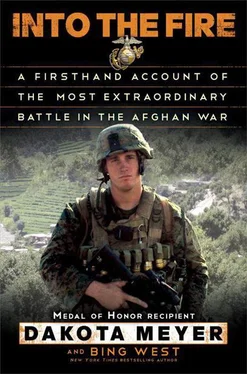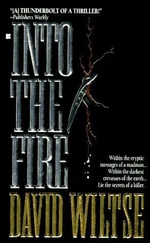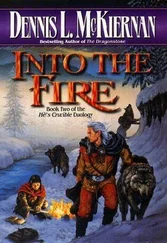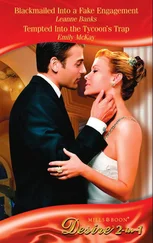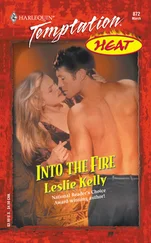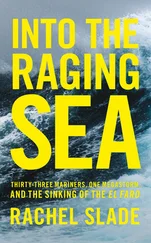Five minutes later, the helicopter ops center called back, saying re-tasking of the birds had been canceled because Lantz had not called his own brigade headquarters to ask permission and because another mission north of Ganjigal was of “higher priority.”
The refusal was too much for Shadow 4 up on the southern ridge. Sgt. Summers came back on the net, shouting that Ganjigal was “a heavy TIC,” meaning that Swenson’s requests should take priority and that the helicopters should be re-tasked immediately. Capt. Harting ignored Shadow’s plea and did not immediately call his brigade headquarters to demand air support.
Capt. Kaplan heard that exchange and passed the bad news to Swenson.
“We are not getting any air,” Kaplan radioed. “They said it was unavailable.”
Down in the dirt where bullets were dusting up the ground around him, Swenson burst out laughing at how ridiculous the situation was. Harting had already acknowledged an estimate from the Shadow observation post that “thirty to sixty AAF” (Anti-Afghan Forces) were attacking. Ten minutes later, the TOC again received requests from Shadow for smoke in order to break contact. The requests were “denied twice due to proximity of structures.” The TOC assessed the enemy to number up to sixty—and wouldn’t authorize fire support.
Swenson and Fabayo sat stunned.
Lt. Johnson again contacted Fabayo on the radio.
“You need to bound back to us,” Fabayo said. “We have to fall back.”
“We’re pinned,” Johnson said. “If we leave, we’ll get shot. Get us smoke to get out of here.”
Swenson knew there was no smoke coming, so he called for white phosphorus rounds.
“We need Willie Peter,” Swenson radioed to the TOC at Joyce.
White phosphorus is a sticky, gummy substance that burns intensely. It throws off a cloud of thick white smoke and is routinely used to conceal the movement of troops. Swenson wanted the Willie Peter to explode along the edge of the village. That way, the enemy machine-gunners would be shooting into a fog bank, permitting Team Monti to fall back to Swenson’s position on the lower steps of the terrace.
White phosphorus is permitted by the UN Convention governing the rules of war. But during the Fallujah battle in Iraq in 2004, charges that Willie Peter had burned civilians created an uproar in the press. The TOC at Joyce denied Swenson’s request, explaining that the village was too close.
More than an hour into the fight, the situation was as follows: Team Monti was trapped in a house; the U.S. and Afghan commanders were pinned down by shooters closing in on them from three sides; the north and south observation posts were under fire; the Askars were caught in the open with nowhere to hide; Rod and I hadn’t reached the wash; the 1-32 quick-reaction platoon was not quick-reacting; the TOC at Joyce was paralyzed, preventing artillery support; and the helicopter gunships had not arrived.
Maj. Peter Granger, the executive officer now in command of the battalion while the highly competent Lt. Col. Mark O’Donnell was on leave, kept a cot in his office outside the TOC. Whenever he walked into the TOC, he was in charge as the senior man. But his occasional appearances only reinforced Capt. Harting’s hesitancy.
“They [the Marine advisors and Afghan officers] didn’t know where all their soldiers were,” Granger said later. “They didn’t know if they’d be calling fire on their own. They didn’t have SA [situational awareness].”
I could hear Swenson’s angry voice on the radio. How the hell was he to know where everyone was? That wasn’t the point. He knew where the machine guns were—in the hills around the village. Some from the lead platoon had run by him, streaming blood and shouting, some without their helmets or rifles. As he grabbed at two of them, bullets chipped the stones at his feet. All three flopped down as rounds cracked overhead.
Some Askars, pinned down, weren’t returning fire. Dushmen with AKs were sneaking forward on the far sides of the terrace walls, picking off Afghan soldiers lying helpless on the ground. The Askars were targets, waiting to be hit in the beaten zone.
Swenson wanted a massive artillery barrage. Because the dushmen didn’t have overhead cover, artillery airbursts would send millions of lancets racing down toward them. Hundreds of shells had to shake the mountains and roll thunder down the valley. The dushmen were zealots, but they weren’t crazy. Once artillery began exploding overhead, gunmen with AKs wouldn’t get up and run forward in the open. Each salvo of four artillery shells exploded with enough blast and red-hot shrapnel to blanket an entire football field.
Yet the TOC refused to fire at Ganjigal, only a few miles from Camp Joyce. Unleashing a barrage in your own backyard wouldn’t win any applause at higher headquarters. The directive from the high command was clear: do not employ “air-to-ground or indirect fires against residential compounds, defined as any structure or building known or likely to contain civilians, unless the ground force commander has verified that no civilians are present.”
After the fight had raged for over an hour, the TOC at Joyce finally directed Dog Platoon to prepare to move forward to the valley as “a potential QRF [quick-reaction force].” The platoon leader, Lt. Bielski, replied that he had not been given a grid location for a link-up with the force in the valley, and he hadn’t been told how far he was to advance. Again, there was hesitation.
With Dog Platoon unwilling to help, Maj. Williams handed his cell phone to his interpreter, asking him to call for an Afghan quick-reaction force. Soon Afghan Humvees were leaving Camp Joyce—without any Americans from 1-32 joining them.
Fabayo began talking to Johnson about an egress route, when he saw friendly mortar rounds landing on KE 3365.
First Sgt. Garza watched the eight 120-millimeter shells detonate with no effect on the enemy rate of fire. Worse, many of the Askars were no longer returning fire. Some had emptied their magazines; others, not accustomed to the new M16s, had experienced jams and thrown away their rifles.
The Command Group was taking fire from three sides: from the village to their front, from the ridges to the south, and from the terraces to the north.
Lt. Johnson came back on the net, again requesting smoke “to conceal their movement.” I heard him give a grid, exactly where he wanted the shells to land. He was calm on the radio. Shadow, the Army outpost on the southern ridge, replied that the TOC at Joyce said the fire mission was too close to the village.
“Too close to the village?” Lt. Johnson said. “If you don’t give me these rounds right now, I’m gonna die.”
“Try your best,” Shadow replied, knowing the TOC wouldn’t fire.
Try your best? From the tone of Shadow’s voice, I knew he was on the verge of complete rage. He wanted to strangle the officers in the TOC at Joyce. I felt the same way. This couldn’t be happening. We were on the same side. We weren’t Marines or soldiers; we weren’t Americans or Askars. We were one lone group fighting desperately to stay alive. The villagers weren’t our friends. This was war, and my team was on the verge of dying. Whose side was the TOC on?
Radio call after call, Swenson kept requesting smoke. Finally, around 0630 the TOC at Joyce permitted four white phosphorus rounds to be fired into the southeast backside of the village, too far away to conceal my team. Those were the last rounds fired during the battle.
At about 0640, the TOC at Joyce forbade any more artillery support, citing garbled communications, incomplete calls for fire procedures, and a lack of situational awareness on the part of those trapped in the valley.
Читать дальше
